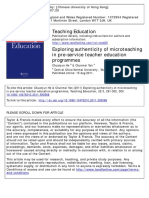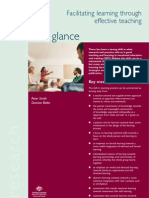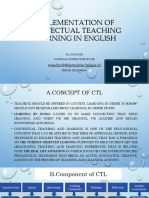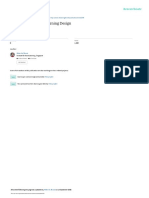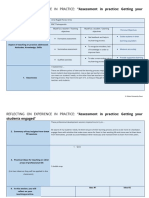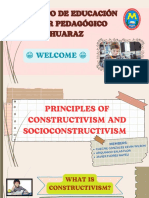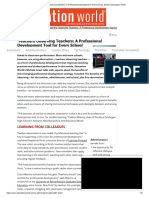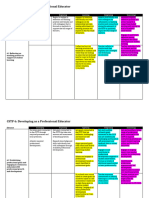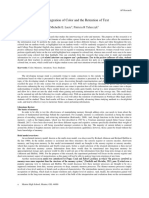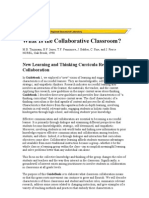Maam Jana Infographic-Final
Maam Jana Infographic-Final
Uploaded by
Jurnelene Lei UGOSCopyright:
Available Formats
Maam Jana Infographic-Final
Maam Jana Infographic-Final
Uploaded by
Jurnelene Lei UGOSOriginal Title
Copyright
Available Formats
Share this document
Did you find this document useful?
Is this content inappropriate?
Copyright:
Available Formats
Maam Jana Infographic-Final
Maam Jana Infographic-Final
Uploaded by
Jurnelene Lei UGOSCopyright:
Available Formats
Constructivist Pedagogy
Teaching-learning approach in Social Science needs to be
revitalized towards helping the learner to acquire knowledge and
skills in an interactive environment. Constructivism sees learning
as a dynamic and social process in which the prior understanding
and the social setting of students are taken into account.
8 factors
that are essential in Constructivist's Pedagogy
AUTHENTIC AND REAL-WORLD
ENVIRONMENTS ARE NECESSARY
FOR LEARNING TO TAKE PLACE
SOCIAL NEGOTAITION AND
MEDIATION SHOULD BE TAKEN INTO
ACCOUNT IN ANY FORM OF LEARNING
CONTENT AND SKILLS ARE MADE
SIGNIFICANT TO THE LEARNERS
LEARNER’S PRIOR KNOWLEDGE IS
FUNDAMENTAL IN THE ACQUISITION
OF CONTENT AND SKILLS
FORMATIVE ASSESSMENT SHOULD BE
DONE TO INFORM FUTURE LEARNING
EXPERIENCES CONSTRUCTIVISM ENCOURAGE
LEARNERS TO BECOME SELF-
REGULATED, SELF-MEDIATED, AND
SELF-AWARE
TEACHERS SHOULD ACT AS GUIDES
AND FACILITATORS OF LEARNING
TEACHERS MUST EMPLOY MULTIPLE
PERSPECTIVES AND REPRESENTATIONS
Modeling
Role of
Coaching
Scaffolding
Teachers Facilitator
EX Constructivism requires that teachers become facilitators
of knowledge not conduits. The teacher’s role is to
create experiences within which students will learn and
then guide the students through those experiences; is a
form of scaffolding’ (Doolittle and Hicks 2001)
Examples of
Constructivist Pedagogy
Cooperative Learning Hands-on Activities
EXPLANATION: It allows students
of upper primary level for
Films EXPLANATION: These
encourage students to
development to become active in manipulate their environments
social collaborative activities. EXPLANATION: These
provide visual context or a particular learning tool.
Such activities require that Teachers can use a checklist
students work primarily in and thus bring
another sense into the and observation to assess
groups. The groups do not have student success with the
to be of any certain size, large learning experience.
particular material.
or small.
In a nutshell.... it can be concluded that the constructivist approach
allows a different perspective on education, we see
also different measurement and evaluation activities.
That is why... in the constructivist approach, in place of
product-oriented learning, focusing on the
process of learning by an exhibition, project
work, portfolio, scoring key diagnostic tree,
checklists, performance evaluation, self-
assessment, alternative assessment tools such
as peer reviews should be used.
You might also like
- Seixas y Morton. The Big Six Historical Thinking ConceptsDocument36 pagesSeixas y Morton. The Big Six Historical Thinking Conceptsfernando contreras100% (1)
- Williams - Burden CH 3 What Do Ts Bring - Psychology For TeachersDocument14 pagesWilliams - Burden CH 3 What Do Ts Bring - Psychology For TeachersClaudia Maria Beatriz Muiño100% (2)
- Teaching Reading in Small Group PDFDocument246 pagesTeaching Reading in Small Group PDFRoberto Rodriguez100% (3)
- SEI Capstone ProjectDocument21 pagesSEI Capstone ProjectAshley Green100% (6)
- Literature and SocietyDocument28 pagesLiterature and SocietyAyomikun Oluwafemi Idowu100% (1)
- Learning Outcomes For Portfolio - FinalDocument1 pageLearning Outcomes For Portfolio - FinalNicholas BransonNo ratings yet
- Act 4-7Document5 pagesAct 4-7Alexa Sofiyah AcordaNo ratings yet
- What I Know About Class ActivitiesDocument1 pageWhat I Know About Class ActivitiesClaire Sasan BacarroNo ratings yet
- Curdev Final ModuleDocument4 pagesCurdev Final ModuleMimi ZuluetaNo ratings yet
- CSTP 6 Jimenez 042224Document12 pagesCSTP 6 Jimenez 042224api-678376918No ratings yet
- Teaching Education: To Cite This Article: Chuanjun He & Chunmei Yan (2011) Exploring Authenticity of MicroteachingDocument13 pagesTeaching Education: To Cite This Article: Chuanjun He & Chunmei Yan (2011) Exploring Authenticity of MicroteachingsuryasaNo ratings yet
- Presentation ConferenceDocument16 pagesPresentation ConferenceankitachhayaNo ratings yet
- Project Based LearningDocument8 pagesProject Based LearningDanny Garcia100% (1)
- At A Glance: Facilitating Learning Through Effective TeachingDocument12 pagesAt A Glance: Facilitating Learning Through Effective TeachingMuhammad Bin RazaliNo ratings yet
- Workshop Constructivism Introductory UnitDocument8 pagesWorkshop Constructivism Introductory UnitNatalia NavarraNo ratings yet
- Problem-Based Learning - Deck 5 - PBL AssessmentDocument44 pagesProblem-Based Learning - Deck 5 - PBL AssessmentKartyka NababanNo ratings yet
- SyllabusDocument13 pagesSyllabusKj bejidorNo ratings yet
- Edl273 CeihoeksemaDocument3 pagesEdl273 Ceihoeksemaapi-361639521No ratings yet
- Unit 1. TASK 1 PDFDocument6 pagesUnit 1. TASK 1 PDFAskarot ln100% (1)
- Tubigan - Modern Approaches Applicable To College TeachingDocument4 pagesTubigan - Modern Approaches Applicable To College TeachingihlaNo ratings yet
- Implementation of Contectual Learning in Teaching EnglishDocument29 pagesImplementation of Contectual Learning in Teaching Englishandri santosaNo ratings yet
- Activity-2 AssigmentDocument1 pageActivity-2 AssigmentKatRina NarazumagNo ratings yet
- PMCFDocument2 pagesPMCFArnel TatoyNo ratings yet
- The Six Principlesof Learning DesignDocument16 pagesThe Six Principlesof Learning DesignAlejandra EstrellaNo ratings yet
- Tyler's Model Taba's Model: SimilaritiesDocument2 pagesTyler's Model Taba's Model: SimilaritiesMariam D. MarcojosNo ratings yet
- Edu 609 D 8Document7 pagesEdu 609 D 8api-610591673No ratings yet
- 5 Families - Teaching StrategiesDocument1 page5 Families - Teaching StrategiesZiyan SheriffNo ratings yet
- EDUC-126-Module-5 - SUMAMBOT, MARYJEL C.Document29 pagesEDUC-126-Module-5 - SUMAMBOT, MARYJEL C.Maryjel Carlom SumambotNo ratings yet
- Mrk_Fall 2024_EDU101_1_BC230205613Document3 pagesMrk_Fall 2024_EDU101_1_BC230205613Wahab AftabNo ratings yet
- Unit 3 Contextualising Teaching Practice As A Component of TeacherDocument13 pagesUnit 3 Contextualising Teaching Practice As A Component of Teachernkele098No ratings yet
- The Six Principles of Learning DesignDocument16 pagesThe Six Principles of Learning Designcomenius2014No ratings yet
- Geometry Rubric Professional Development Rubric 1 1 1Document2 pagesGeometry Rubric Professional Development Rubric 1 1 1api-470953927No ratings yet
- PDM Reflection ActivityDocument4 pagesPDM Reflection ActivityurielNo ratings yet
- Assessment As Learning Fundamentals andDocument7 pagesAssessment As Learning Fundamentals andJulia P. AndradeNo ratings yet
- P Connections Professional DevelopmentDocument2 pagesP Connections Professional Developmentapi-470953927No ratings yet
- Human Resource ManagementDocument14 pagesHuman Resource ManagementSS41MontillaNo ratings yet
- Initiative and Self Direction - Group 4 1Document2 pagesInitiative and Self Direction - Group 4 1Veronica Abata BaldozNo ratings yet
- School That Redefines Learning.: Competitions - Uni.xyzDocument13 pagesSchool That Redefines Learning.: Competitions - Uni.xyzHarshit LaddhaNo ratings yet
- Care Kim Scoular EducadoresDocument12 pagesCare Kim Scoular EducadoresRegie AsisNo ratings yet
- 14 LearninG ALBERTDocument6 pages14 LearninG ALBERTArlyn ElsiNo ratings yet
- CSTP 6 AlvaradoDocument8 pagesCSTP 6 Alvaradoapi-679251480No ratings yet
- Power Point About Work Values, Occupational Engagement, and Professional Quality of Life in Counselors-in-Training: Assessments in A Constructivist-Based Career Counseling CourseDocument9 pagesPower Point About Work Values, Occupational Engagement, and Professional Quality of Life in Counselors-in-Training: Assessments in A Constructivist-Based Career Counseling CourseFitria Rahmaini IINo ratings yet
- My 21st Century Classroom Facilitating SkillsDocument2 pagesMy 21st Century Classroom Facilitating SkillsNitaflor GanioNo ratings yet
- CSTP 6 Nguyen 9Document8 pagesCSTP 6 Nguyen 9api-492431821No ratings yet
- Learning Innovation Grant Application Rubric: CreativityDocument1 pageLearning Innovation Grant Application Rubric: Creativityapi-321244529No ratings yet
- Constructivist ApproachDocument27 pagesConstructivist Approachmarlene.faundoNo ratings yet
- My 21st Century Classroom Facilitating SkillsDocument5 pagesMy 21st Century Classroom Facilitating Skillscindy laraNo ratings yet
- Research Paper Education: Dr. M. Parimala Fathima DR - AR.SaravanakumarDocument9 pagesResearch Paper Education: Dr. M. Parimala Fathima DR - AR.SaravanakumarJoan JohnNo ratings yet
- ADDITIONAL ACTIVITIESDocument4 pagesADDITIONAL ACTIVITIESjagapeguillermoNo ratings yet
- Module 3 BEED 3A RACHEL C. TUPLANO Assessment of Student Learning 2Document7 pagesModule 3 BEED 3A RACHEL C. TUPLANO Assessment of Student Learning 2Lemwell BiloNo ratings yet
- Principios Del Constructivismo y Socioconstructivismo.Document11 pagesPrincipios Del Constructivismo y Socioconstructivismo.Kevin GonzalesNo ratings yet
- EDUC 103 Module 2 2T 2018 2019Document4 pagesEDUC 103 Module 2 2T 2018 2019Pau CervantesNo ratings yet
- Notes 2 Facilitating Learner Centered TeachingDocument9 pagesNotes 2 Facilitating Learner Centered TeachingCute KoNo ratings yet
- Assessment No. 1 - 3Rs TemplateDocument4 pagesAssessment No. 1 - 3Rs TemplateDREW BASNIGNo ratings yet
- Good Teacher Performance FrameworkDocument16 pagesGood Teacher Performance FrameworkScribdTranslationsNo ratings yet
- Teachers Observing Teachers - A Professional Development Tool For Every School - Education World Step 5Document5 pagesTeachers Observing Teachers - A Professional Development Tool For Every School - Education World Step 5nathalialqsNo ratings yet
- RubricDocument3 pagesRubricwarkaoakaNo ratings yet
- College of Education: Field Study 4Document5 pagesCollege of Education: Field Study 4Ivy RasonableNo ratings yet
- Professional Development - Empowerment CollaborativeDocument1 pageProfessional Development - Empowerment Collaborativeapi-734900066No ratings yet
- CSTP 6 Neri 7Document12 pagesCSTP 6 Neri 7api-679230020No ratings yet
- CSTP 6 Dorrego 7Document7 pagesCSTP 6 Dorrego 7api-679001490No ratings yet
- Task 1 Teacher Development ReflectionDocument10 pagesTask 1 Teacher Development ReflectionIed Nacionalizado Jerusalen Sede LA VictoriaNo ratings yet
- White Illustrative Creative Literature Project PresentationDocument22 pagesWhite Illustrative Creative Literature Project PresentationKay JayNo ratings yet
- Republic of The Philippines Region XII Division of General Santos CityDocument7 pagesRepublic of The Philippines Region XII Division of General Santos CityJurnelene Lei UGOSNo ratings yet
- Lesson Plan in Science CHECKEDDocument7 pagesLesson Plan in Science CHECKEDJurnelene Lei UGOSNo ratings yet
- Lesson Plan in Science 2Document8 pagesLesson Plan in Science 2Jurnelene Lei UGOSNo ratings yet
- Lesson Plan in Science 3 - RevisedDocument5 pagesLesson Plan in Science 3 - RevisedJurnelene Lei UGOS0% (1)
- Journey With King David: Part - 3Document14 pagesJourney With King David: Part - 3Jurnelene Lei UGOSNo ratings yet
- Journey With Samuel: An Introductory Lesson For KING DAVIDDocument17 pagesJourney With Samuel: An Introductory Lesson For KING DAVIDJurnelene Lei UGOSNo ratings yet
- Philippine National Police Police Regional Office 12Document4 pagesPhilippine National Police Police Regional Office 12Jurnelene Lei UGOSNo ratings yet
- The Integration of Color and The Retention of Text: Michelle E. LucicDocument7 pagesThe Integration of Color and The Retention of Text: Michelle E. LucicJurnelene Lei UGOSNo ratings yet
- Unit 4: WorksheetDocument7 pagesUnit 4: WorksheetJurnelene Lei UGOSNo ratings yet
- Edukasyon: SA PagpapakataoDocument13 pagesEdukasyon: SA PagpapakataoJurnelene Lei UGOSNo ratings yet
- After BrainstormingDocument1 pageAfter BrainstormingJurnelene Lei UGOSNo ratings yet
- CREATIVE WRITING Questionnaire 1 Module 4Document6 pagesCREATIVE WRITING Questionnaire 1 Module 4Jurnelene Lei UGOSNo ratings yet
- Ghanaian Language CCP Curriculum B7 B10 Draft ZeroDocument86 pagesGhanaian Language CCP Curriculum B7 B10 Draft Zeromujahidhussein617No ratings yet
- S3 - APADV - Handout 3.19 - Selected Session 3 Powerpoint SlidesDocument121 pagesS3 - APADV - Handout 3.19 - Selected Session 3 Powerpoint SlidesbmNo ratings yet
- Correction Techniques ThornburyDocument2 pagesCorrection Techniques ThornburyCristian Daniel OsolosNo ratings yet
- Middle School Competency Based Grading InitiativeDocument40 pagesMiddle School Competency Based Grading InitiativeKeung HuiNo ratings yet
- CM AssignmentDocument10 pagesCM AssignmentSilvina AbibNo ratings yet
- What Is The Collaborative Classroom?: New Learning and Thinking Curricula Require CollaborationDocument27 pagesWhat Is The Collaborative Classroom?: New Learning and Thinking Curricula Require Collaborationapi-27788847No ratings yet
- Herbert Puchta's 101 Tips For Teaching TeenagersDocument128 pagesHerbert Puchta's 101 Tips For Teaching TeenagersCesar BarbatoNo ratings yet
- School Learning Action Cell Session: First Quarter-Kindergarten Slac Session 1Document7 pagesSchool Learning Action Cell Session: First Quarter-Kindergarten Slac Session 1Anthonette Calimpong Bermoy-BurgosNo ratings yet
- Just Speak Up 3Document10 pagesJust Speak Up 3김은숙No ratings yet
- Novice Teachers Training and Support NeeDocument13 pagesNovice Teachers Training and Support Neezgr2yhf7wpNo ratings yet
- PEAC 2022 Learning Plan TemplateDocument18 pagesPEAC 2022 Learning Plan Templateaila nikka prietos100% (1)
- Making PredictionsDocument3 pagesMaking Predictionsapi-350017442No ratings yet
- PDF Let's Lecture Less 2012 Edition in Color 78 Pages With References To Kirschner, Sweller, and Barak RosenshineDocument78 pagesPDF Let's Lecture Less 2012 Edition in Color 78 Pages With References To Kirschner, Sweller, and Barak RosenshineJk McCrea100% (2)
- UbD Unit PlanDocument11 pagesUbD Unit PlanLauren EricksonNo ratings yet
- Kindergarten Lesson Plan 5Document5 pagesKindergarten Lesson Plan 5alyssamanningNo ratings yet
- Proceeding 4th Ismei - FinalDocument412 pagesProceeding 4th Ismei - FinalAchmad NizarNo ratings yet
- LE 1 Educational TheoriesDocument12 pagesLE 1 Educational TheoriesRomina DaquelNo ratings yet
- TBLT - TBI Resumen ActualizadoDocument12 pagesTBLT - TBI Resumen ActualizadoagostinaNo ratings yet
- Unit TemplateDocument10 pagesUnit TemplateCrystal ZhaoNo ratings yet
- Chapter 3 Lessons 1 4Document12 pagesChapter 3 Lessons 1 4Maturan Guila MarieNo ratings yet
- Pirochta Assignmenttwo Te802Document6 pagesPirochta Assignmenttwo Te802api-331472106No ratings yet
- Quiz Classroom Mgt.Document11 pagesQuiz Classroom Mgt.Alan LedezmaNo ratings yet
- FREE PBoard Prof EDDocument17 pagesFREE PBoard Prof EDGiselle Jerah ChingNo ratings yet
- Ast Lesson Plan 2 Math - 2Document30 pagesAst Lesson Plan 2 Math - 2api-534848602No ratings yet
- Sara Westin Resume WeeblyDocument2 pagesSara Westin Resume Weeblyapi-273674062100% (1)
- Sociocultural Theory A. Views of Lev Vygotsky's Sociocultural TheoryDocument6 pagesSociocultural Theory A. Views of Lev Vygotsky's Sociocultural TheoryShania andrisaNo ratings yet










